Openings and Closings
The timing could not have been more precise. My phone rang; a friend calling to deliver worrisome, though not disastrous, medical news about a mutual friend. “The warranties on our middle-aged bodies,” I remember thinking, “have well and truly run out. We are all starting to show our manufacturing defects, and there is no RMA available. It’s fix or toss, now.” And even as we talked through what this meant in the immediate term, an unfamiliar number with a 608 prefix rang me.
My cell phone number dates back to Boston, and the other number I maintain to New York City, so my personal daily cloud of no-see-em spam phone calls come to me from 617 and 917: any call from a 608 number I assume to be real. On top of that, I answer pretty much any call when I’m not physically around my kids. This was a no-brainer: I apologized to my friend and took the call.
I didn’t recognize the voice.
“This is your wife.” (It was not my wife.) “I’m with your wife.” (That made more sense.) “Piper’s been in an accident here on the bike path. I’m going to put your wife on the phone.” (A brief flapping and fumbling as the phone changed hands.) “It’s me,” Kate said, in a voice all focus and fear behind a tourniquet of concentration. “I need to you to pick up Syd and meet us at the Children’s Hospital. A biker hit Piper on the head. We’re calling 911 now. It’s bad.”
“Okay,” I said. “I’m on it.” I held the phone for a moment before asking, “Just how bad is it? What’s your read?” Nothing from Kate as an eternal few seconds fell echoing down a well, and then: “Just come.“I signed off from work, grabbed a backpack of books and tablets for the inevitable hospital waits, and drove carefully, so carefully, to pick up six-year-old Syd from her after school program. I explained as we drove that Piper had been hurt in an accident, I didn’t know how badly, and that we were going to the hospital to meet her and Mama. That we’d all be together. That Piper might need stitches. At this, Syd’s reaction clarified: “I can help her take care of stitches. I’ve had those before.” (After a concussion 18 months ago and having a mole removed the year before that, Syd justifiably became our child most expert in trauma and wound recovery.) As we parked, Syd stayed calm, didn’t fret, and on hearing that I’d brought only the iPad, immediately said that Piper could play with it. “Our youngest kid is growing up,” I thought.
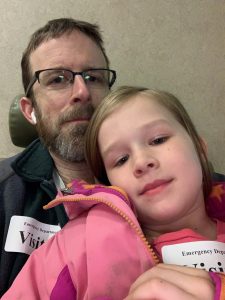
Syd, on my lap
We walked in, checked in, and got visitor stickers. The nurses at the front desk told us that Piper was “just getting settled,” and that someone would bring us in shortly. I feigned patience at the wait, which was simultaneously about 2 minutes and 2 years.
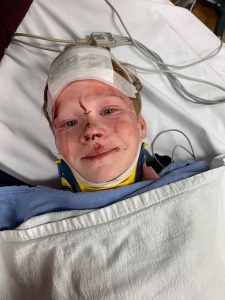
Piper, first brought into the hospital
A nurse came to bring us back to Piper and Kate, in room number 1. Piper was horizontal on the bed, spattered around the face and head with blood, and wearing a cervical collar. This child, this child who whines when confronted with a dishwasher to empty, this child who fusses when she has to set down a book to come eat dinner: this child of mine was looking around quietly and listening to the staff as they prepared to shift her to a transport bed. I stepped to the bed and took her hand and met her eyes, which welled up with tears. “Hi, Abba,” she said. Her voice was low. “I love you.” “I love you so much, you,” I said. “Boy, you’re a mess.” She laughed, just a little, and at that instant I knew she was going to be okay.
They rolled her down from room 1 to room 42, warning her every time they adjusted the bed height that there would be a loud noise. Child Life staff talked with both Piper and Sydney to see if they needed distracting, though Syd wanted nothing more than unfettered access to Minecraft and Piper nothing beyond removing the cervical collar (no joy, yet) and to continue listening to “The Wee Free Men,” which we’d started. (I will always carry an engrossing audiobook on my phone from here on out; I swear the evening to come would have been three times as miserable without its distraction.)
First came a series of in-room X-rays to image her sore elbow and road-rashed knees. Staff wearing heavy lead aprons shooed us out into the hallway, where Kate spoke with a police officer who’d taken other statements at the scene, including from the biker. The officer’s take, having heard from four different people, was that the guy had seen the flock of kids on and around the bike path, begun to slow, swerved to avoid one kid crossing the path and in so doing, ran into Piper. To all accounts, he was shaken and contrite.
I listened in with half an ear, looking at the X-ray techs and weighing in when they had a long, uncomfortable pause while looking at the bone growths around Piper’s knees. “That’s due to a family trait for osteochondromas,” I said, to their seeming relief that they didn’t have to inform us of something else we weren’t expecting.
Next they wheeled her off to get a head CT scan, provoking a series of dad-jokes (from me, natch) about “CAT scans,” which managed to get chuckles from both kids. I know that the period of time in which I’ll remain funny to them is ticking away, and man, I am treasuring it. Having previously blobbed numbing gel onto the insides of her elbows, the nurse placed an IV on Piper’s right arm, to which her anticipation was far worse than the pin-prick reality.
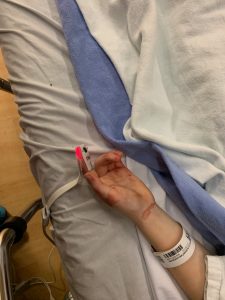
Lots of waiting. Waiting punctuated by dribbles of information from residents, nurses, and the super-cheerful, bearded attending doc. Promises from each person to a steadily complaining Piper that they would go and ask about the go-ahead to remove the cervical collar, followed by an aggrieved sigh from Piper and another request “to turn Tiffany Aching back on.” Waiting as Kate and Syd went to get quesadillas from the cafeteria, and waiting as we semi-surreptitiously ate them in front of Piper, who was still not allowed to eat or drink anything in case they needed to put her under, later.
Hospitals run on procedure, after all, and even when every individual staff member is kind (as they were) and considerate (ditto), one enters a hospital as maze of rules and flow-charts through which one finds the exit only after seemingly endless waits and approvals. The approval to remove the collar and allow Piper to sit up in bed came at last, and the evening took a great step for the better.
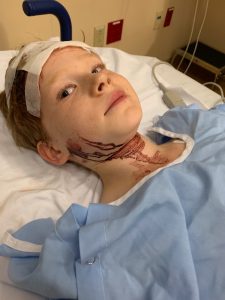
It’s amazing how much better someone starts to look with less visible blood on their face.
An ENT resident came and pulled back the bandage to inspect the wound, which was … dramatic. Kate had quietly told me that when she first saw it she had thought Piper’s skull fractured, and even forewarned, I could see why: the cut was wide, bloody and right down to the bone. Her hair, sticky and matted, was stuck to the edges and needed gentle work (“ouch!") to unstick.
The next flow-chart to begin was how to numb the area for later work. First topical LET gel the color of maple syrup (“It stings!"). 45 minutes later, discussion of how they’d do the stitching: in the OR under general (“probably overkill”), at the bedside with Versed (“it lasts a while, though”), at the bedside with nitrous oxide (“the only concern being we might run against the time limit and have to turn it off mid-way”), or at the bedside simply with local anesthetic. Kate’s baby-patients get a lot of Versed, apparently, but the attending came in, and after speaking with Piper said that his inclination would be proceed simply with local anesthetic, keeping nitrous or Versed available if needed. “She’s tolerating all this so unbelievably well,” he said, “that my hunch is that’s all she’ll need.”
And so began what would turn out to be the worst part of the evening: local injections for the for-real anesthetic. Piper held my hand and squeezed a toy frog from the Child Life specialist’s bag of tricks, yelping each time the needle went under her skin, all around the edge of the wound. “Okay, Piper,” said the specialist. “Big deep breaths.”
As a toddler, we had taught Piper that taking big deep breaths would get her through a lot of upset, and she’d used this technique until around five or six years old, when she discarded it, much to our frustration. But now, to my amazement, when she needed it most: she took big, deep, breaths, squeezed the rubber frog, whimpered a bit and managed to get through at least 12 injections, all of them pretty intense. (“It burns!")
Once that needle went away, Piper’s experience of the evening improved dramatically. The resident sluiced an unbelievable amount of saline in and under the wound, affording me repeated views of the underside of her scalp and the pale white surface of her actual holy crap skull. Kate whisked Syd home for a swift but as-normal-as-possible bedtime; my dad came over to sit in the house as Kate came back, just in time for the beginning of suturing.
And suturing. And suturing. The resident doing the work had warned us that three layers of stitches would take quite a while. I stood at the bedside, looking in Piper’s eyes (and under her scalp, again, holy crap) while we listened to The Wee Free Men. 40 minutes in, the surgeon paused for a second to appreciate having a book to listen to. “Last week I was stitching a kid and it was just ‘The Wheels on the Bus Go Round and Round’ on repeat. For an hour. This is way better.”
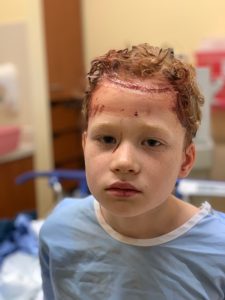
The evening had gone on too long by this point.
One set of stitches for the paper-thin muscular layer next to the bone. One set for the lower, fatty layer under the skin. One final set, nearly thirty, for the surface layer of skin. Thick gobs of antibiotic paste for the surface, since the surgeon had casually mentioned to us that “these kinds of wounds are never really all that clean to begin with.”
I navigated my way down into the bowels of the hospital to find the one place still selling pre-packaged food at 10:30, returning with a crustless peanut-butter and jelly sandwich and a turkey wrap with fruit. We threw away the shirt they’d cut off Piper on her arrival. Piper picked at the fruit and wrap as they began the process of releasing us, and started exhaustedly weeping as we headed for the door. The emotional release of having the ordeal actually done with brought on a rush of pent feelings. “I wish this had never happened,” she sobbed as we buckled her into the car, wrapped in donated clothes and my grey hoodie. “I wish I didn’t have this scar.”
Then home, where we set her up to sleep in what will soon be her own room, to avoid waking up with the early alarm the next morning. “I don’t want to go to school,” she muttered, brushing her teeth. “The kids are going to make fun of my scar.” We assured her that her experience would be far more jealous celebrity, a la Madeline, than any kind of Harry-Potter teasing.
At 11:20, I had a glass of wine, recounted the evening with dear friends in California, and tried to get myself to a state in which I’d be able to sleep. The nearness of the miss and the unbelievable luck came jolting through to me, and have continued to do so in the days since. A hit that hard could have mangled her face, damaged her throat, broken bones or concussed her. As it was, she had been hit by a bicycle on the exact hardest spot from which one would want to head a soccer ball. She displayed not a single concussion symptom, and she tolerated stitching with remarkable aplomb. Lucky, lucky, lucky.
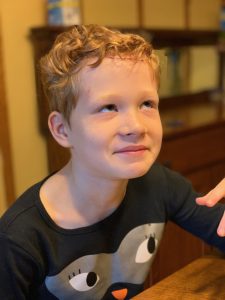
The next morning, rolling her eyes at a dad joke.
The next morning she slept in, ate a massive breakfast, and reluctantly went to school, going in a few hours late. By afternoon, she came strolling back into the house with one of her best friends, breezily announced she’d be going over to her house, and proclaiming how happy she was that she went back to school.
And that was that.